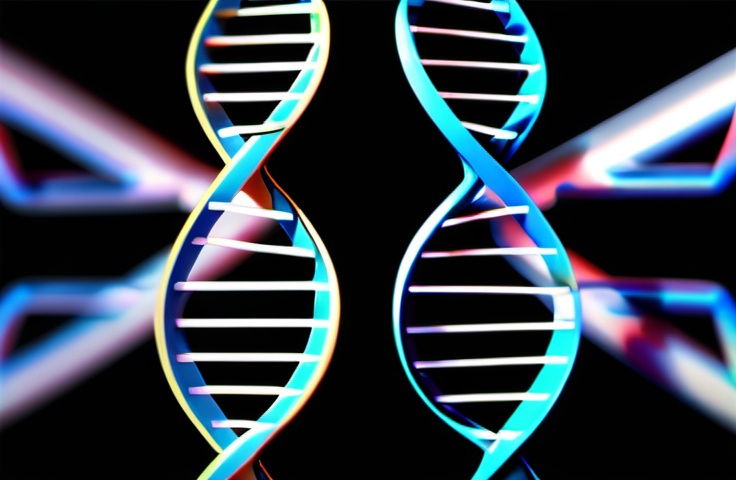Scientists are programming one of the world’s hardiest, most radiation-resistant organisms to rewrite a specific gene, allowing them to cure a common type of inherited high cholesterol. Dubbed TnpB and originating from the bacterium Deinococcus radiodurans, this exceptionally robust microbe also survives cold, dehydration, vacuum, and acid, making it an ideal tool for genetic editing.
Although the team has only tested its “genetic scissors” on mice models with an inherited predisposition to a type of high cholesterol called hypercholesterolemia, which currently affects 31 million Americans, the researchers believe their approach will one day allow them to cure high cholesterol in humans by essentially rewiring their genetic code.
Reprogramming TnpB to Cure High Cholesterol
In the published study outlining the new genetic reprogramming approach, the researchers note that genetic editing has shown significant promise in editing certain inherited health conditions by essentially “reprogramming” specialized bacteria to genetically edit the faulty gene in a person’s genetic code with a properly functioning one. However, the process, made famous by the CRISPR gene editing tool, has resulted in mixed successes.
One of the primary limiting factors of the CRISPR-Cas organism most commonly used in genetic editing is its size. According to the study authors, the microbe is too large to be precisely targeted, which “creates challenges when trying to deliver them to the right cells in the body.”
More recently, researchers in genetic editing have begun to focus on the organism’s “evolutionary progenitors,” some of which are much smaller than the CRISPR-Cas microbe. Among the most promising is TnpB, whose smaller size and hardiness offer scientists a new path for genetic editing.
These smaller progenitors are less efficient at reprogramming and show limited targeting ability due to their limited recognition requirements when binding DNA than the larger CRISPR-Cas microbes. Now, the researchers behind this study say they may have finally overcome that limitation, resulting in a much more efficient method of targeting TnpB to cure high cholesterol.
New Method Shows Up To 75% Efficiency
According to the study, the team found a way to optimize TnpB to edit mammalian cells more efficiently than the untreated organism.
“The trick was to modify the tool in two ways: first, so that it more efficiently goes to the nucleus where the genomic DNA is located, and second, so that it also targets alternative genome sequences,” said Kim Marquart, a PhD student at the Institute of Pharmacology and Toxicology at the University of Zurich (UZH) and the study’s first author.
Next, the team tested 10,211 separate targeting sites to identify which features in the cells’ DNA determine the microbe’s overall editing efficiency. Instead of testing the sites individually in a lab setting, the team used a specialized artificial intelligence tool that they say could predict the organism’s editing efficiencies as the different targeting sites.
“Our model can predict how well TnpB will work in different scenarios, making it easier and faster to design successful gene editing experiments,” said Marquart. “Using these predictions, we achieved up to 75.3% efficiency in mouse livers and 65.9% in mouse brains.”
Following the success of the models, the team engineered their customized microbe in the lab. These microbes were tested on mice programmed with the genetic variant that causes hypercholesterolemia. The team hoped its smaller size would allow this progenitor to CRISPR-Cas to go where the larger organisms could not.
“For the animal experiments, we were able to use clinically viable Adeno-associated viral vectors to efficiently transport the tools into mouse cells,” Marquart explained. “Due to its small size, the TnpB gene editing system can be packaged into a single virus particle.”
In contrast, the team notes that the more commonly used CRISPR-Cas9 components must be packaged into multiple virus particles,” which means that higher vector doses need to be applied.”
Developing Similar Gene Editing Strategies in Humans
As hoped, the team found their more efficient TnpB organism was ideally suited for the task, with its efficiency dramatically outpacing its original form.
“By engineering the small but powerful protein TnpB, we were able to design a variant that shows a 4.4-fold increase in efficiency of modifying DNA – making it more effective as a gene editing tool,” explained project leader Gerald Schwank from the Institute of Pharmacology and Toxicology at the University of Zurich (UZH).
After receiving the programmed organism, the mice with their faulty gene showed healthy cholesterol levels. In effect, the new approach showed that smaller microbes could reach the DNA target and cure high cholesterol.
“We were able to edit a gene that regulates cholesterol levels, thereby reducing the cholesterol in treated mice by nearly 80%,” Schwank explained.
Moving forward, the team hopes to expand their research, including looking for ways to improve their customized gene editing tool’s efficiency further. While only at the animal model stage, the team believes their approach could lead to a genetic tool to cure high cholesterol and other inherited conditions that the traditional CROSPSR tool cannot cure.
“The goal is to develop similar gene editing strategies in humans in order to treat patients suffering from hypercholesterolemia,” Schwank said.
The study “Effective genome editing with an enhanced ISDra2 TnpB system and deep learning-predicted ωRNAs” was published in Nature Methods.
Christopher Plain is a Science Fiction and Fantasy novelist and Head Science Writer at The Debrief. Follow and connect with him on X, learn about his books at plainfiction.com, or email him directly at christopher@thedebrief.org.

